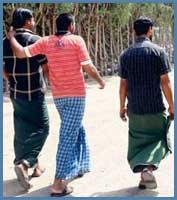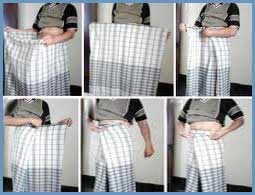
The lungi is a traditional type of wrap-around garment worn in many of the southern states of India. The Lungi a rectangular piece of cloth little bigger than a towel and is wrapped around- kind of like a sarong. In Kerala, the lungi, locally known as Kaili or Kalli Mundu is mostly worn by both men and women. It is considered a casual dress or working dress of physical labourers. Lungis are generally colourful, and with varying designs. The plain white version of a lungi is known as a mundu. For more ceremonial occasions (like weddings), mundus often bear a golden embroidery known as kasavu.
The Lungi (also known by many other names, sometimes with some delicate differences between them) is a long piece of cloth wrapped around the waist, that is popular in various parts of India, especially in South India. It can be worn by both men and women, and can be worn as a wrap unstitched, or with a simple privacy stitch.
While a lot of people use these terms interchangeably, there are distinct differences between the terms. The Dhotar or Dhoti is made with very fine cotton and is much longer in length than a Veshti or Mundu, which are not designed to run between the legs. One can go to a wedding in Dhoti, but never in a Lungi. The Lungis and Mundu can be worn in half-fold.
Unlike dhotis, which are like linear sheets, lungis are sewn into a tube shape like a skirt. Depending on local tradition, lungis can be worn by men and/or women, are tied or fastened in various ways, and can be used in different cultural activities, ranging from normal daily life to elaborate wedding ceremonies. For daily purposes, a simple double knot is most popular, since it is least likely to slip or come undone. Another way of wearing is it by draping it around the waist and pleating it in the front at the groin.
Kerala men folk generally tuck up their mundus or lungis. The bottom of the garment is pulled up and tied back on to the waist. This would make the mundu or lungi only cover the body from the waist to the knees. In this fashion it somewhat resembles a kilt, but without pleats. The lungi is thought to be quite comfortable, as its length can be adjusted rather easily. It is particularly popular in regions where the heat and humidity create an unpleasant climate for trousers.
The Lungi Song
When in white, you are my formal wear.
When in design, you are a festival!
What good are those trousers?!
If I wrap you around my head,
you become a turban.
You are a blanket if I am cold.
And a sail when the wind is bold.
After I play in the sea,
you become my towel.
A flag when I wave
A trap to catch the mango!
Ready for Cricket when I fold you in half,
Ready for hanging when I twist you as a rope
ready as bed when I'm stuck at fairs
You become a shawl when I need modesty
and a carrying bag during a loot.
The trousers are no good!

This is nspired by the "Trousers are no Good!" folksong, which in turn is inspired by the classic "Neenarigadeyo Ele Manava" (the humans are no good).
Perhaps no other Indian attire is as simple, or less cumbersome, as the lungi, which is a garment worn around the waist.
The origin of the traditional lungi can be traced to South India, though the dress is now popular among several other communities of Asia also. Lungi is generally woven from cotton and is available in many designs, patterns and colors. However, the most commonly worn are those with checks or the ones in a single dark hue.
No matter what the color and design of the lungi, there is always a thin line or stripe running horizontally at the top and bottom of this garment. A lungi is different from a dhoti that is a linear-like sheet, because it is sewn into a circle like a skirt. Though it is normally worn by men in India, at some places, you will find the women folk wearing it too. Depending upon the occasion, a lungi is tied or fastened in different styles.
For everyday wear, people simply tie a double knot on their lungi as it is least likely to come undone. Lungi is a popular form of garment in south India, where the severe heat and humidity makes donning trousers unsuitable. In Kerala, it is worn as a casual dress by both men and women, especially by those belonging to the class of physical laborers. A lungi in plain white hue is called a Mundu. For ceremonial occasions like weddings, Mundus often bear golden embroidery, known as kasavu.
Lungis are very popular form of casual wear in South India as they are worn by all classes of people and men use lungi as a casual home-wear in daytime as well as bedtime clothing. Cotton lungis are extremely comfortable to wear in the hot and humid climate mostly prevalent in South India. Many labourers and artisans wear it as the main waist cloth and a regular daily dress.
Lungis which are also known as Kailis in Tamil Nadu are quite popular across Kerala, Karnataka and Andhra states in South India. Lungis are popular in Myanmar, Bangladesh and Srilanka too. The standard cotton lungi is available in a variety of colors with stripes, checks or plain and also in white. They are mostly produced in hand looms and power-looms.The standard lungi is 1.15m in height and 2.0 m in length, when open.
The standard lungis become a comfortable wear only when the open ends are joined and stitched to form a tube like a skirt. However people in Kerala mostly wear lungi in open condition, similar to wearing a dhoti, Veshti or Mundu. In Tamil Nadu, lungis are worn mostly after stitching the ends. The typical way of wearing a lungi in Tamil Nadu ensures a firm grip of the lungi around the waist and it does not get loosened like a Veshti.
How to Wear Lungi

Step:1 Insert the lower body into the tubular lungi .
Step:2 Stretch and flatten the tube so that the lungi touches the navel and back.
Step:3 Not allowing the lungi to fall from the front, swing the hand to one side and grip the lungi to get the first fold.
Step:4 With this grip on one side ensured, swing the hand to the other side to grip. This is to get one ready for the second fold.
Step:5 Now the lungi is firmly held with the two-folds at the waist level around the navel.
Step:6 Now do the first roll by folding the edge downwards over the tummy.
Step:7 Do the second roll and fold. One can do two (or three) more rolls, too to, adjust the overall height and also to increase the grip at ones waist.
Step:8 Now using palms, roll the edge of the lungi downwards against the back. This will increase the grip all around the waist.
When worn correctly, the lungi should give a nice inverted "V" shape at the front. The correctly worn lungi will not get loosened even if one pulls.


